
Snub Nose or Semi-Auto Pocket Pistols?
When you gotta have a Pocket Back-Up
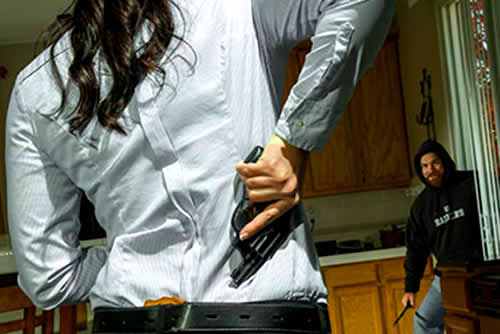
When we dive into pocket guns, one big advantage is the concealment due to the smaller pistol size. Pocket semi-auto and small revolvers like the snub nose type can be a never ending debate to which is better to carry. Both have their pros and cons. If you’re old school (old timer), you may opt for the snubby .38. For the newer generation, probably opt for the semi-auto .380 pocket pistol. We need to point out its easy to distinguish the idea of carrying a smaller pistol when there is something bigger is a better fighting tool. (Just to be clear, we’re talking pocket pistols with a two inch or less barrel and for this post we’re leaving the micro 9’s for another day.)
Let’s go over some factors with these pocket guns. The no-brainer is that with a snub nose – you’ll get top reliability and easier to get to the gun.
With the semi-auto pocket pistol you’ll exchange those qualities in favor of a smaller gun that’s easier to conceal, at least thats what the consensus says.
Factors
Here are some factors between the two pistols to consider:
- Caliber – Most pocket mouse will be be a .380 or .32 ACP, Snubbies do come in .38s but, when shooting with a short barrel less than 3 inches at close range. The differences between the .32, .380 and .38s are relatively none. Its all about shot placement. Though, .38s have more power, we need to put this into the context for personal defense purpose.
- Ammo Capacity – Snubbies are 5 rounds while semi-auto are 6 to 8 rounds.
- Lightweight – With the current technology both pistols are now lighter than their predecessors.
- Costs – This can be within $200 to $400 range, this is a plus for either type of mouse gun.
- Shootability – Recoil, shoot-ability and ergonomics. Being able to shoot a gun well is a good thing. This when viewed from a newbie standpoint, can make the learning curve easier if they choose to go with a pocket gun. Intermediate to advance shooter is a different story based on bias feelings and experiences. Some will say its more comfortable to shoot the semi-auto than a revolver.
Many concealed carriers have stated revolvers have proven to be more reliable than the semi-auto pistols. That is true and with a more curious younger generation wanting to be factual they have gone out and tested this. Findings have found that revolvers can be unreliable as the semi-auto.
Revolvers require more maintenance to keep the running smoothly. Durability with revolvers is not good, especially when dropped. However, in a personal defense scuffle to get the gun out they do outperform the pocket semi-auto. Semi-auto feeds have failed to operate during this hand-to-hand entanglement.

Now, bear in mind the pocket carrier will have these snubbies and/or mouse guns at the waist (IWB) or pocket carry. Sometimes its not easy to get to it while under stress and securing a good grip to fire. With a snub nose doesn’t matter squeeze the trigger and it goes bang. This bang can be from 6 feet away or even when a 300 plus pound guy is on top of you that’s ready to pounce you to submission. Now of course if someone grabs it and keep the cylinder from moving then the snubby won’t go off.
Accessibility
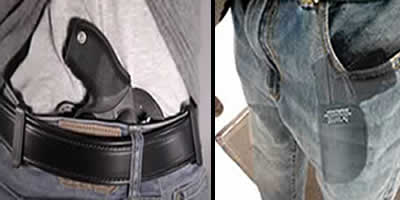
Getting your snubbie or mouse gun out quickly and easily is a very important factor to consider. Easier said than done. You would need to overcome the obstacle of clearing your garment to dig out your equalizer. But, the fact is when you decided to carry a pistol for personal protection. Getting your gun out is a deliberate action that needs to happen.
Which brings us back to the snubbie revolver, its shape and grip offers a better choice than a semi-auto pistol for accessibility. A decent snub nose with a Pachmayr grip is a lot easier to pull out than most semi-auto. Grabbing the pistol from an odd position is no problem. Especially, from the belt, ankle, handbag or even from your pocket.
Size
Most snub nose revolvers are a little bigger than a pocket gun. Have a look at the comparison below. The image below is from Lucky Gunner, its a size comparison between an AirLite snub nose and G42/Kel-Tec P32.

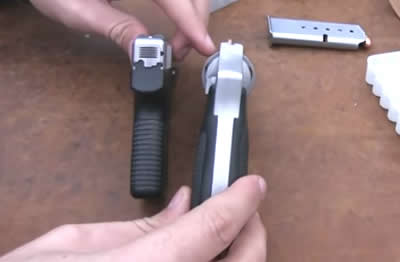
As you can see the snub nose is a little taller and longer in length.
Another Way to View Stopping Power
We need to address this, even though we all know that having a bigger caliber will have more stopping power without looking at the ballistic numbers. Instead we’d like to show you this study from Greg Ellifritz who did a detailed study several years back on the stopping power of various rounds in real word incidents. Looking at the chart below you will see that while the number are not great when compared to bigger handgun rounds they are in the ballpark with much more powerful rounds.


The average number of rounds to incapacitation (counting only center mass hits) is 2.2 which is worse than .22 LR but actually right in line with 9mm and .40 caliber ammunition. The percent of fatalities from .25 ACP is also very comparable, statistically, to both of these rounds as well. Also note that this study factors out the “psychological stops” where mere fact that the victim was armed ended the attack. That number, regardless of the caliber of the firearm, was around 90%.

Looking at the .32 to .38 Special “rounds to incapacitation”, theres not much differences. The bottom line here is that even tiny rounds out of mouse guns can stop an attack and having a gun is far more important than the caliber of the gun you carry.
So yeh, we’re talking about the Indian here and not the arrow. If you’re a skilled shooter that can place shots rapidly in the right spot, you can stop the attacker. Also, remember we’re not cops, we’re just Joe citizen that want to defend ourselves. Whether you do this with your .32 or a rock (to the head) and made the bad guy stop. You’re golden!
Ammo & Performances
The following ballistics information is from Lucky Gunner Lab. Their information is invaluable to have for the pocket carriers. Hopefully, this gives you a realistic look at the ammo and expectations. This is not a complete list of ammo brand/loads and pistols.
.32 Ammo
Here’s the gel ballistics results from decent loads take look below, keep in mind these were shot from a short (2 inches) barrel.

.32 ACP Long
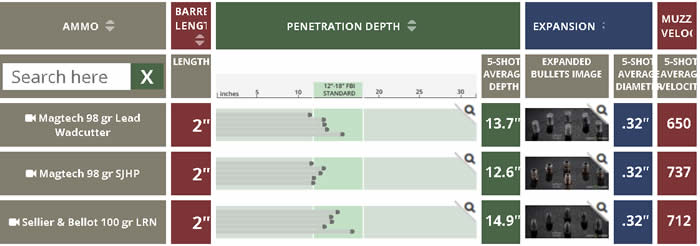
.32 H&R Magnum
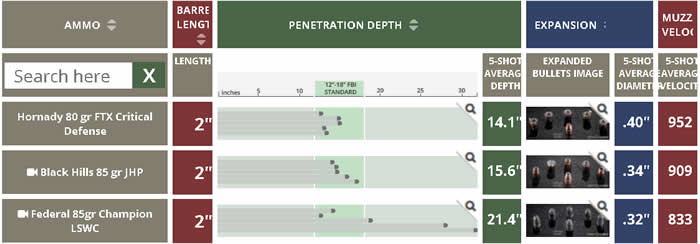
Ruger LCR 327 Federal Magnum

If you’re sticking with the .32 then this Ruger can fire all of the .32 family (short, long, H&R Magnum and Federal Magnum).
Smith & Wesson 332 Ti

Aluminum J-frame, aluminum frame with Titanium alloy cylinder, lightweight at 11.5 ounces. Shooting this is in .32 short is like shooting a .22 magnum, very soft on recoil. Still softer than shooting a .38.
Beretta 3032 Tomcat
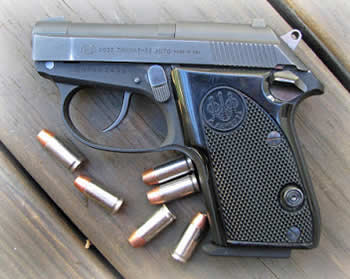
The magazine holds 7 with one in the pipe. If you’re challenged getting the slide back, no need to worry. Just press the lever forward to pop the barrel up and insert a cartridge into the chamber. Snap the barrel down and insert a loaded magazine and you’re good to go. Pretty nifty!
Kel-Tec P32

A deep concealment semi-auto pocket pistol weighing in at 7 ounces unloaded. Holds 7 +1 in the magazine, trigger pull is 5 pounds. Being this small, the hammer block axis pin near the rear of the gun can be a problem for some shooters. It is rough around the edges and sits right on the metacarpal joint of the thumb.
.380 ACP Ammo
Speer 90 gr Gold Dot average 5 shot penetration is at 11 inches.


.380 Auto – 99 Grain JHP – Federal Premium Personal Defense HST
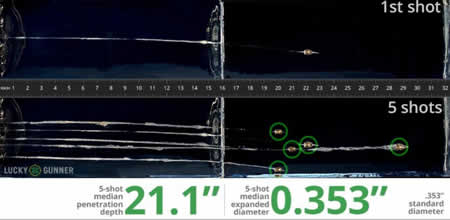
Hornady Critical Defense 90 grn
Sig V-Crown 90 gr
.380 ACP Pocket Pistols
Kel-Tec P3AT
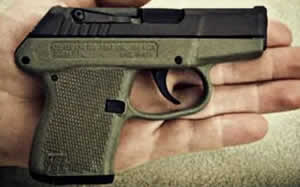
Pocket size for deep concealment, chambered in .380 power with a smooth trigger pull and 6+1 capacity. Warning, being a small pistol, has a tendecy to jump out of the hand while shooting.
Smith & Wesson Bodyguard
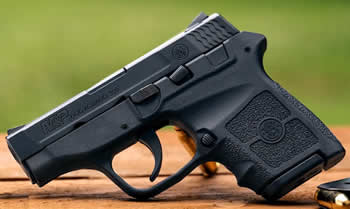
If you’re looking for decent power in pocket size, this Bodyguard is not bad. Some shooters have said must have a good grip on the gun to shoot accurately.
Glock 42
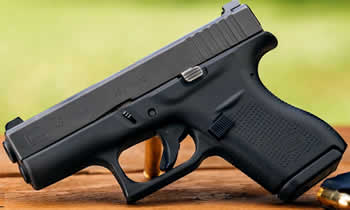
Though this Glock is slightly bigger than most semi-auto pocket pistol. G42 was made easy to shoot for its size.
Felt Recoil Performances
Quick word on “felt recoil“, just like the name that recoil. Comparing a light caliber to a heavier one gives you a sense of what you can control and shoot quickly.
In order to do this you would need to shoot the two different calibers and time yourself. Its not just blasting away but how fast can you get back on sights between the shots.
Using a drill like the 5×5 we can evaluate the effects of recoil. Again its all about how quickly one can recover their sights from recoil and fire the next shot. Take a look at the timed results below:

Note the bigger the caliber the longer it takes to get on target for the next shot. Within the context of self-defense, the more rounds you put into the target accurately and quickly, is what counts. Not the bigger caliber. However, we’ve all been told to stick with the bigger calibers and not really training to get more proficient with it.
Do Real Men have to Pocket Carry?
There you have it, this comparison can be debated into the next decade and beyond. Think the bottom line goes back to the shooter experiences and preferences and this can be difficult to be un-biased.
Understanding pocket pistol role in the bigger firearm picture can help you decide on what you’re willing to carry. Accept the plus and minus for stopping power over concealment, may be hard for the biased shooters to swallow.
We’re not here to say that the pocket pistol calibers (.32, .380) rules over the bigger 9mm or .45 ACP. But, to understand what a shooter can do if you have a smaller caliber pocket pistol to carry when you’re in that non-permissive environment.
Featured Image from AmmoLand.com
